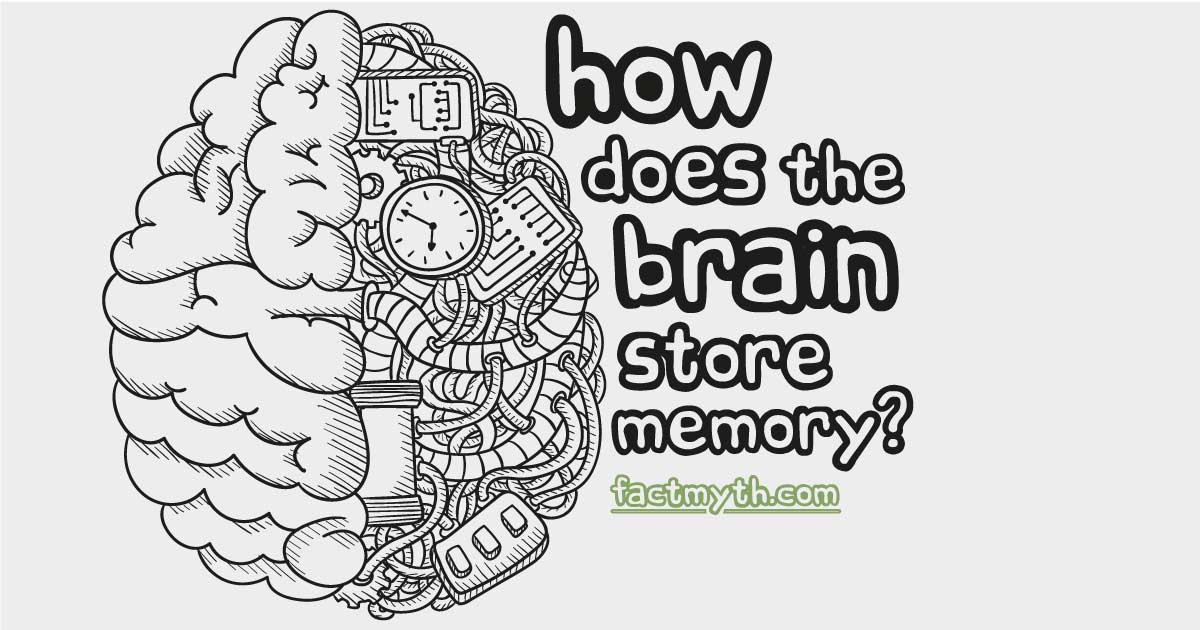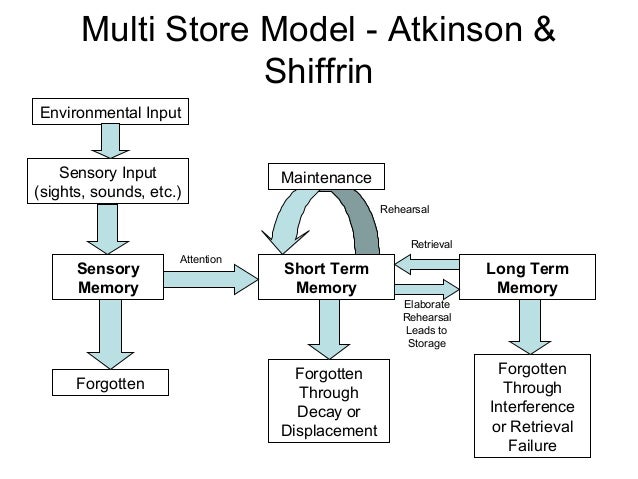There are at least 3 different types of memory, and each type has a number of subtypes. Memory is explained with experimental science, neurological science, and with models. Models are theories. There are many working models for memory, above we presented some of the most important and famous. There is no one way to understand memory, but despite this, there is a lot we do know about how sensory, short term, and long term memory work with the rest of our neurology.
There are Different Types of Memory fact

What are the Different Types of Memory?
There are three basic types of memory: sensory memory (what we perceive), short-term memory (what we think about), and long-term memory (what we know).[1][2][3] These memory types all play a role in how information is encoded, stored, and retrieved.
Below we look at the different types of human memory by using terms from popular memory models (AKA theories). These theories help us to explain what is happening neurologically with memory. With that said, there is no single way to describe what is happening with memory, or a specific agreed on way to state all the memory subtypes and functions.
Below is an in-depth view of the different types of memory according to the most popular current models (according to our research). Please share your thoughts in the comments below. First, this awesome video from Crash Course Psychology.
TIP: To really understand memory you have to understand plasticity and attention.
How We Make Memories – Crash Course Psychology #13. A good introduction to memories.
There are many ways to describe what is happening with memory and the brain. Here is one that shows which parts of the brain are doing what. Make sure to compare and contrast this with the information below. Different models explain memory differently. Source.
Memory Types Overview
Sensory memory is our ability to retain information related to the different senses. Each of the senses has a different “memory store” such as Iconic (visual), echoic (audial), and haptic (touch). When we focus our attention on a sensory memory it moves into short-term memory.[10]
Short-term memory includes working memory. Working memory is the way we process the sensory information we are actively thinking about. Working memory is limited to holding between five and seven items in the mind at a time for up to about 30 seconds each. When information in working memory seems important, it’s transferred to long-term memory (there are different parts of working memory based on the senses and the way logic works, see Baddeley and Hitch model below).[10]
Long-term memory has a lot of storage and can hold information indefinitely. There are two types of long-term memory. Explicit long-term memory is our conscious memory. It includes our declarative memory which is focused on “knowing what” something is. Declarative can be divided into semantic memory (what actually happened) and episodic memory (our impression of what happened), and autobiographical which is a mix of the two. There is also implicit memory, which is an unconscious memory. It includes our procedural memory, a type of long-term memory focused on “knowing how” something works and priming (being primed by experiences). Implicit can be broken down further. Some also classify temporary long-term memory as intermediate-term memory.[10]
Beyond this, there is also a distinction between original and recalled memories and generally the way the different types of memory work together with attention in the memory process. Every time we remember something; we change the memory slightly as our brain puts the puzzle back together. See how this affects our memories accuracy here.

What Makes the Memory Types Different?
Each memory type has a unique storage and temporal capacity. Each also uses different parts of the brain in regards to encoding, storing, and retrieving sensory information.
FACT: What we think of as “memories” are collections of sensory memories stored in sensory-specific neurons and connected in the neural networks in our brain. When we recall an event our brain pieces together a memory based on previously made connections.
A video from Khan Academy looking at how the brain processes sensory, working, and long-term memory.The Baddeley and Hitch Model of Memory Explained
There are a few different models, or theories, of how to describe the memory process. The updated Baddeley and Hitch model below is widely accepted and useful for understanding how our brain processes sensory information and interacts with long term memory.
Simple version of the working memory model: Sensory input -> sensory memory -> attention -> working memory -> long-term memory.[7]

Fig 1. The Working Memory Model (Baddeley and Hitch, 1974). Source.

An example of one of the other memory models. Please notice the Atkinson & Shiffrin model has a lot of similarities to Baddeley & Hitch. All the models work off the same knowledge bank but add to the visualization process.
Sensory Memory
We can pick up and store memories from any sensory input (sensory memory). The most common types of sensory memory talked about are visual and audial. Smell, touch, taste, and spatial sensory information, as well as many non-traditional senses an also be stored.[7]
Different types of sensory information stimulate different types of neurons and different parts of the brain. Sensory information is quick in and quick out, but it has the ability to leave imprints.[10]
- Iconic memory: Memory for what you see is vivid, but lasts typically for half a second.
- Echoic memory: Memory of what you hear usually lasts for 3 – 4 seconds.
- Haptic memory: Memory is based on what you touch.
FACT: We have 5 traditional senses, plus many more non-traditional senses. Our brain stores everything from emotion to pain, to pressure, to spatial information using unique parts of the nervous system.
Attention
Our brain keeps sensory memory information for a very short period of time. Then we must decide (consciously or subconsciously) which of these information blips to orient our attention to and store in short-term working memory (AKA short-term memory or just working memory).
NOTE: Attention is also used to recall short-term memories from long-term memory and to focus our short-term memory. Attention works hand-in-hand with memory on every level.
Short-term Working Memory
The brain can store about 5 – 7 pieces of information in working short-term memory. This is the information a person can hold in their conscious mind and alternate their focus between.
Different parts of the brain are used to work with different types of sensory data in working memory. The Baddeley Hitch model postulates this as a single “central executive” controlling “information processors”. Each processor focuses on a different type of sensory information and logic. Using these processors, we can work through short-term memory.[7]
The Updated Working Memory Model (Baddeley and Hitch)
 The Working Memory Model (Baddeley and Hitch, 1974) plus episodic buffer model (2000). Source.
The Working Memory Model (Baddeley and Hitch, 1974) plus episodic buffer model (2000). Source.
- Central Executive: “The boss of working memory”. It allocates data to the visual and audio parts to process. It also deals with other cognitive tasks like mental arithmetic and problem solving.
- Visual-Spatial Sketchpad (inner eye): The part that stores and processes visual or spatial information.
- The Phonological Loop: Which deals with spoken and written information via:
- Phonological Store (inner ear): Which can store information linked to speech perception for 1 – 2 seconds.
- Articulatory control process (inner voice): Which can be used to store and process verbal information.
- The Episodic Buffer: Added by Baddeley in 2000 after the modeled failed to explain results from experiments. The Buffer acts as a ‘backup’ store, which communicates with both long-term memory and the components of working memory.
In the 1 – 20 seconds the information from your senses is stored in working memory you must (either consciously or subconsciously) use your “brain power” decide which pieces of information are useful. Useful information is transferred to long-term memory; non-useful pieces of information are discarded.
Long-Term Memory
Long-term memory can last anywhere from a few moments to a lifetime. Essentially everything we are is sensory memories stored long-term memory, in different parts of our brain, in neurons, connected by neural networks. Let’s examine the types of long-term memory.
Explicit Memory AKA Declarative
Declarative memory refers to long-term memory that we can consciously recall. This can be broken down into two types.
- Semantic memory: What Actually happened. Facts, events, and things that we explicitly or purposefully store.
- Episodic memory: Our impression of what happened. Emotions, context, and associations.
- Autobiographical: A mix of semantic and episodic.
Implicit Memory AKA Non-Declarative
Implicit memory refers to memory that we subconsciously recall, like riding a bike. Things we implicitly or “accidentally” store. It can be categorized as priming and procedural (but sometimes is subcategorized further into perceptual, conditioning, and ‘Habituation and Sensitization’).
- Procedural memory: When we are able to carry out commonly learned tasks without thinking about them (like riding a bike).
- Priming memory: An implicit memory effect in which exposure to one stimulus influences the response to another stimulus.
- Perceptual memory: Serves to identify objects and structure of language.
- Conditioning memory: Emotional and reflex based “conditioned” memory. Like Pavlov’s dog. Also called behavioral conditioning.
- Habituation sensitization: Related to conditioning, a type of non-associative memory that allows us to filter out non-useful stimuli without thinking about it.
Original Versus Recalled Memory
When we originally encode and store a memory it’s as accurate as we perceived it. Every time we recall it we put the memory back together again from our neural network of sensory information. Every time we recall a memory we alter it.

This graphic (source) shows different long-term memory types for both the collective and the individual.
Synaptic Plasticity
Every time you perceive and process sensory input your brain rewires itself based on which neurons and synaptic pathways are used. This means that each stimulus you give attention to (willingly or as a reflex) shapes your world. The more attention and thought you use in the process the stronger a connection becomes.
Memories aren’t just blips of information. Each memory gets recorded as many blips with a complex matrix of connections between them. When we recall memories they can end up being vastly different than what actually happened as what we know is constantly evolving. This is great for learning new information but makes issues like eyewitness testimony unreliable and problematic.
Seeing the Memory Matrix
I found this helpful chart that connects most of what you need to know about how memory works together. Source. In short, if you are confused this chart helps explain why.
- “Types of Memory“. human-memory.net. Retrieved Feb 5, 2016.
- “Working Memory“. Simplypsychology.org. Retrieved Feb 5, 2016.
- “What are the differences between long-term, short-term, and working memory?“. Ncbi.nlm.nih.gov. Retrieved Feb 5, 2016.
- “Working memory“. Wikipedia.org. Retrieved Feb 5, 2016..
- “Short-term memory“. Wikipedia.org. Retrieved Feb 5, 2016.
- “Spatial and non-spatial working memory at different stages of Parkinson’s disease“. Ncbi.nlm.nih.gov. Retrieved Feb 5, 2016.
- “Evolution of working memory“. Pnas.org. Retrieved Feb 5, 2016.
- “MEMORY RECALL/RETRIEVAL“. Human-memory.net. Retrieved Feb 5, 2016.
- “SENSORY MEMORY“. Human-memory.net. Retrieved Feb 5, 2016.
- “Memory“. Memorydr.com. Retrieved Feb 5, 2016.

